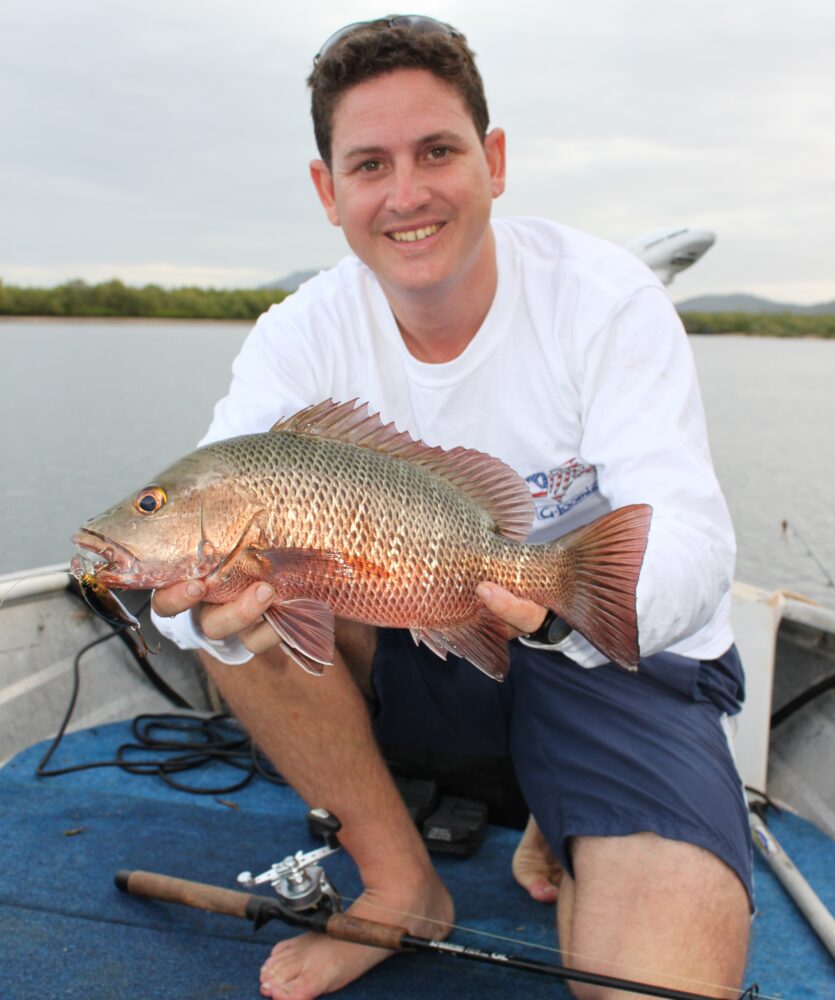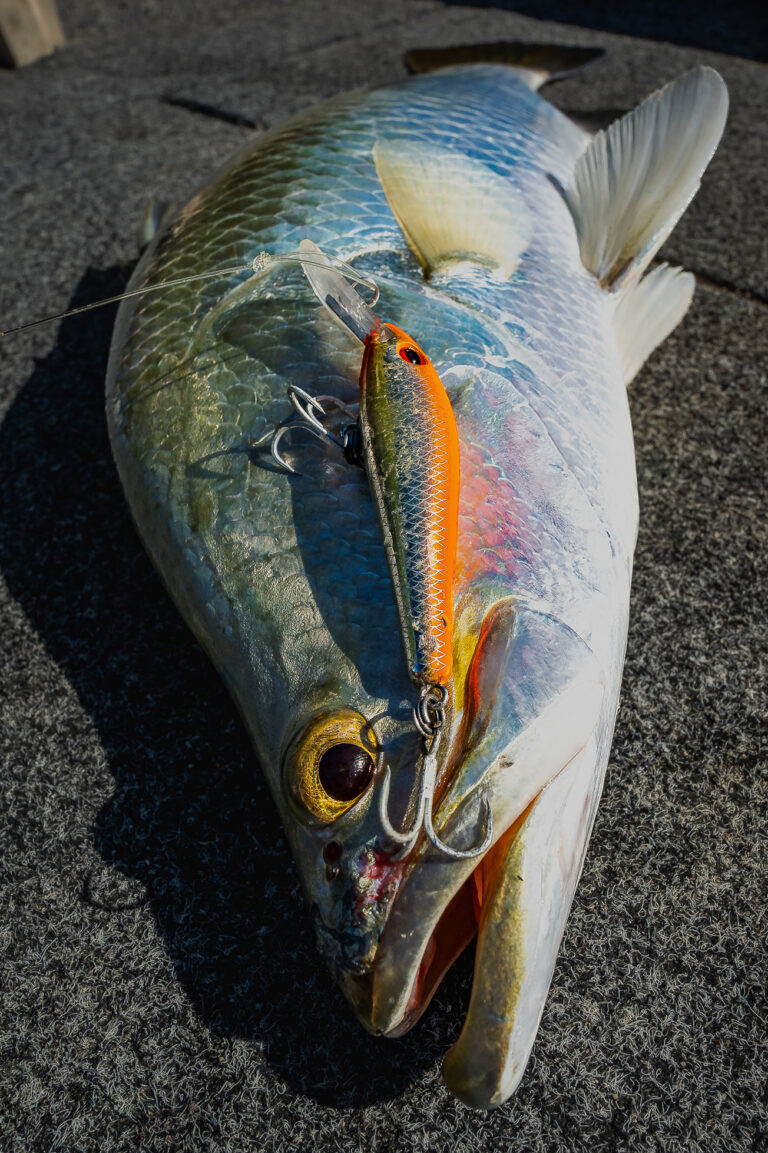Suspending Success – By Dan Kaggelis
One of the biggest advantages hardbody lures have over soft plastics is the ability to suspend. Being able to wind a lure down to a desired depth and get it to sit right in the face of a fish is very hard to beat. Barra in particular are an absolute sucker for a suspended lure because of the way they feed due to the position of their eyes.
They love to get under a lure, line it up, before nailing it. There is no doubt that a slow rising suspended lure provides all the ingredients to make this magic happen.
In the early days, suspending lures were made of timber and some of my absolute favourites were the timber built Tilson’s and Richo’s. These suspending lures were the downfall of many a barra and for many years they were my go-to barra lures. I firmly believe that if you want to learn the true intricacies of lure fishing then mastering the art of fishing suspending lures is the best place to start. It really takes lure fishing to a level of mastery as you can begin to become more in touch with your lure and its properties. I am grateful that I was able to begin my lure fishing journey using these types of lures for this very reason.

One of the winter barra which fell victim to the suspending action of the TBarra80.
Unfortunately, timber built suspending lures have become a rarity these days and it’s not for the reasons many anglers believe. It’s not because they are too expensive to make or they are easier to make out of plastic, it’s because the quality and consistency of timber these days is just too impossible to source. Without this consistency each individual lure will be weighted differently. Too heavy and the lure will sink too quickly and too light and it will rise too quickly. This is so crucial to the lure’s success, so it’s not something you can take to chance.
So, what’s the best way to get the most out of your suspending hardbody? First you need to match the size of your lure to the fish you are chasing. When it comes to suspending lure size, I reckon the biggest mistake anglers make is going too big. Unless you are chasing big fat barras in the Dams, anything between 80cm and 100cm is perfect. In fact, it is better to go too small than too big. The reason for this is because smaller medium size lures around the 80cm size are a lot easier to control when being suspended. Also being a little smaller means, you can use longer bibs which will get your lure down to the optimum depth quicker. One of the most important things with using suspending lures is to get that lure down to the desired depth as quickly as possible. If you can see barra on your sounder sitting at 3 metres, then you want to make sure you get your lure down to that depth as quickly and as steeply as possible so you can stop winding and allow the lure to suspend in their faces. Some lures plane down slowly which means you have to cast a long way in front of the fish to get it down to depth. Some dive really quickly and aggressively and a very fast couple of winds will get you down with little ground lost. These fast-diving lures are far better because you don’t always have the area to get your lure above the fish. Using a reel with a very high-speed retrieve will also help with this as the faster the retrieve the quicker the dive.
Knowing what depth you want to suspend your lure at is also vital. This is where using your sounder in down imaging mode is so important. You really need to get your lure sitting either just above the fish or in front of them. I prefer to go in front of the fish at the same level and rely on a slow rise to encourage the bite. This preference ensures the lure is clearly seen by the fish and allows them to take up the feeding position below it.
The final crucial element is how you get that lure to move when it is suspending mid water. The biggest mistake made by anglers here is to fish the lure too quickly. To get the best out of your suspending lure you need to leave it mid water as long as you can. This translates to small twitches then leaving it sit for at least ten seconds. Then repeating the process. If I can’t get a strike out of the fish, I will pause the twitch and retrieve for even longer, sometimes up to 30 seconds which gives the fish plenty of time to consider what’s in front of them. On most occasions the fish won’t strike the lure on the twitch, but when the lure is paused, so it pays to be in full contact with the lure at all times.

The ever-trusty Halco hardbodies were my go-to lures in my younger days. This one was one of my all time favourite lures.
I have recently had the privilege to fish a range of different suspending lures and it’s fair to say there are some really awesome suspending lures on the way to stores as we speak. One lure which has really stood out of the pack has been the Halco TBarra80. Halco are renowned for making great lures and their Tilsan Barra lures have been a big favourite of mine for a long time and TBarra80 was going to have to perform exceptionally well to match it.
One thing I first noticed about the TBarra80 was it had that classic Halco hardbody shape and profile. You could tell it came from a tried and tested foundation which is so essential for lure performance. The next feature that stood out was its size. Coming in at 80cm, this size allows it to target a range of species, not just barra. In saying that, when fishing it I had no complaints from all sizes of barra who were more than willing to boof it down. Another plus was it was really easy to cast, especially into really tight spots and making that perfect cast. Even with all these positive features the real test was how well it would suspend. As mentioned before, achieving that perfect weight is so crucial to the success of a suspending lure. One of the biggest factors which can affect weight are the terminal tackle used on the lure, in particular choice of trebles. Barra lures require strong trebles, however the draw back of strong trebles is they can be very heavy which can severely impact the lures suspension performance. The use of BKK 4xx on the T80 has been an excellent choice as they are barra strong but not too heavy that the lure doesn’t sink like a stone. Its large bib got the lure down to depth quickly and suspended mid water well with a very slow rise. When you twitch the lure ever so slightly it brings the lure back to or very close to the initial depth. This allows the angler to suspend the lure, let it rise ever so slightly, then get it back down allowing the angler to repeat the process again. On a recent trip this proved to be so important. Being in the middle of winter the water temp was around 20 degrees. It was also colder than usual as recent rain had brought cold water off the mountain and into the river. It’s always tough chasing barra in the winter but this was going to make it so much harder. With the tide beginning to run I decided to move away from snag bashing and chasing those one or two fish and concentrate on fishing bigger schools of barra. More barra equals more chances of success as there is bound to be at least one hungry fish amongst them. It didn’t take long to find the fish on my Humminbird Helix. It was a school of around twenty fish which were hanging in the back water of a large rock face in 3 metres of water. I moved up stream and spot locked and began casting over the fish and cranking it down as quickly as I could. After a few casts I could feel the lure hit the rock face in front of the fish which told me my lure was almost in the zone. Employing a few more quick rips saw the lure swim into the gutter behind it. This was exactly where the largest concentration of barra were sitting. Now it was just a matter of leaving the suspending lure to do its thing. I employed a few small twitches and paused the retrieve for around 5 seconds.
Three casts in and it was nailed as it slowly drifted upwards by a solid barra.
Once I had the technique down it took about 10 casts to get another bigger barra on board before the school spooked and moved away. There’s something really rewarding when you catch fish like this as 99 percent of success comes down to how well your lure performs and the TBarra80 was definitely up to the challenge that day.
In closing if you haven’t fished suspending hardbodies then give it a go. The TBarra80 is a very good lure to get you started as it has all the attributes that make suspending lures so successful. Most importantly the TBarra 80 lives up to Halco’s well deserved reputation for making some of the best lures on the market.





